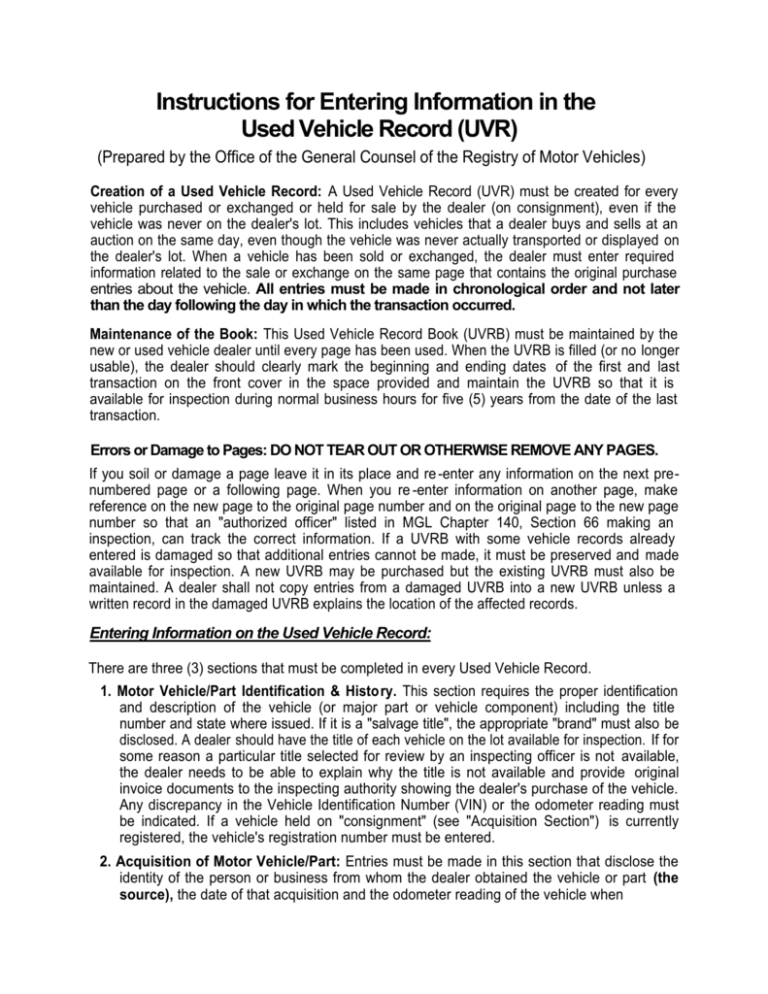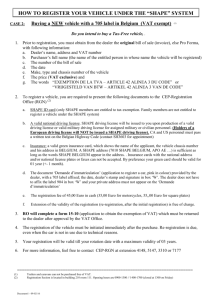Used Vehicle Record (UVR) Instructions for Dealers
advertisement

Instructions for Entering Information in the Used Vehicle Record (UVR) (Prepared by the Office of the General Counsel of the Registry of Motor Vehicles) Creation of a Used Vehicle Record: A Used Vehicle Record (UVR) must be created for every vehicle purchased or exchanged or held for sale by the dealer (on consignment), even if the vehicle was never on the dealer's lot. This includes vehicles that a dealer buys and sells at an auction on the same day, even though the vehicle was never actually transported or displayed on the dealer's lot. When a vehicle has been sold or exchanged, the dealer must enter required information related to the sale or exchange on the same page that contains the original purchase entries about the vehicle. All entries must be made in chronological order and not later than the day following the day in which the transaction occurred. Maintenance of the Book: This Used Vehicle Record Book (UVRB) must be maintained by the new or used vehicle dealer until every page has been used. When the UVRB is filled (or no longer usable), the dealer should clearly mark the beginning and ending dates of the first and last transaction on the front cover in the space provided and maintain the UVRB so that it is available for inspection during normal business hours for five (5) years from the date of the last transaction. Errors or Damage to Pages: DO NOT TEAR OUT OR OTHERWISE REMOVE ANY PAGES. If you soil or damage a page leave it in its place and re -enter any information on the next prenumbered page or a following page. When you re -enter information on another page, make reference on the new page to the original page number and on the original page to the new page number so that an "authorized officer" listed in MGL Chapter 140, Section 66 making an inspection, can track the correct information. If a UVRB with some vehicle records already entered is damaged so that additional entries cannot be made, it must be preserved and made available for inspection. A new UVRB may be purchased but the existing UVRB must also be maintained. A dealer shall not copy entries from a damaged UVRB into a new UVRB unless a written record in the damaged UVRB explains the location of the affected records. Entering Information on the Used Vehicle Record: There are three (3) sections that must be completed in every Used Vehicle Record. 1. Motor Vehicle/Part Identification & History. This section requires the proper identification and description of the vehicle (or major part or vehicle component) including the title number and state where issued. If it is a "salvage title", the appropriate "brand" must also be disclosed. A dealer should have the title of each vehicle on the lot available for inspection. If for some reason a particular title selected for review by an inspecting officer is not available, the dealer needs to be able to explain why the title is not available and provide original invoice documents to the inspecting authority showing the dealer's purchase of the vehicle. Any discrepancy in the Vehicle Identification Number (VIN) or the odometer reading must be indicated. If a vehicle held on "consignment" (see "Acquisition Section") is currently registered, the vehicle's registration number must be entered. 2. Acquisition of Motor Vehicle/Part: Entries must be made in this section that disclose the identity of the person or business from whom the dealer obtained the vehicle or part (the source), the date of that acquisition and the odometer reading of the vehicle when acquired. The dealer must indicate if the vehicle was purchased or traded-in and, if the dealer did not purchase the vehicle personally, he must identify the name of the employee or agent who purchased it for him. If the source of the vehicle (the seller) indicated whom he had obtained the vehicle or part from, the dealer must also enter that information in the UVRB. For example, if Ace Auto Sales in Boston acquires a vehicle from King Auto Sales in Worcester, and King says he acquired the vehicle from Queens Auto Sales in Springfield, Ace is required to make the following entry where required: "The source of the motor vehicle or part [King] indicated it was obtained from: Queens Auto Sales, Springfield, MA." A Note About Consignment Sales: A dealer must indicate in the UVR if a vehicle is held on Consignment. The legal right of a dealer to engage in consignments is limited. RMV regulations at 540 CMR 18.02 (2)(a) 6 prohibit a licensed motor vehicle dealer who has been issued a "Dealer" General Registration and Plate by the Registrar from offering vehicles for sale anywhere other than the licensed premises of the dealer (except for sales at recognized automobile auction facilities or at combined-dealer special sale events). Therefore, a dealer who has been issued "Dealer Plates" may not display other dealers’ vehicles on his own lot or display his own vehicles on other dealers' lots. However, a licensed Class I or Class 2 dealer who has been issued a Dealer Plate by the Registrar may display a vehicle for sale on the dealer's own lot that is owned by a private party and held for consignment, but the vehicle must be entered in the dealer's Used Vehicle Record Book as a "consignment" vehicle. The dealer cannot attach its own Dealer Plate to allow a demonstration drive of the consigned vehicle by a potential buyer because the dealer does not own the vehicle. If the vehicle's private-party owner is willing to authorize a demonstration drive for a potential buyer, the private-party owner should review his/her ins urance policy to determine if a demonstration drive is covered by the policy. If the private -party owner authorizes a demonstration drive, his or her own valid registration plates should be left on the vehicle if the insurance covers such drive. Note that if a dealer finds a buyer for a consigned vehicle which was displayed on the dealer's lot, on terms acceptable to the private-party owner, the dealer must first purchase the vehicle from the private-party owner before selling it to the buyer. The transaction must be in accordance with the Regulations of the Attorney General at 940 CMR 5.00 for the retail sale of motor vehicles and the warranty coverage required by state and federal law will apply and the vehicle cannot be delivered without proper execution and delivery of the Certificate of Title. 3. Disposition of Motor Vehicle/Part: Entries must be made in this section that disclose the identity of the person or business to whom the dealer transferred the vehicle or part (by sale or exchange), the date of that transfer and the odometer reading of the vehicle when transferred. The dealer must indicate if the vehicle was sold or traded and, if the dealer did not dispose of the vehicle personally, he must identify the name of the employee or agent who sold or traded it for him. If a DRT-1 Form was used for the transfer the dealer must enter the control number from the top of the DRT-1 document. Note that a DRT-1 Form is a controlled form. A dealer who has been issued DRT-1 Forms by the Registrar is personally responsible for and must be able to account for each form. A DRT-1 Form cannot be passed from dealer to dealer. Used Vehicle Record Book Requirement — M.G.L. c. 140, § 62 Every licensee shall keep a book on the licensed premises, in such form as shall be approved by the Registrar, in which, at the time of the purchase, sale, exchange, or receipt for the purpose of sale, of any second hand motor vehicle or parts thereof, sha ll be legibly written in the English language an account and description of such motor vehicle or parts, with the name and address of the seller, of the purchaser, and of the alleged owner or other person from whom such motor vehicle or parts were purchased or received or to whom they were delivered, as the case may be. Such description, in the case of motor vehicles, shall also include the identifying number or numbers required by the Registrar, and shall also include a statement that the identifying numbe r or numbers have been removed, defaced, altered, changed, destroyed, obliterated or mutilated if such is the fact. Penalties for Failing or Refusing to Grant Access For Inspection: A penalty is provided by M. G. L. c. 140, § 67 of a fine of up to $200.00 or by imprisonment for up to one year, or both, for a licensee, clerk, agent or other person in charge of the licensed premises, who refuses to admit an authorized officer to enter the premises to examine motor vehicles and parts, and all books, papers and inventories relating thereto, or who wilfully hinders such officer from entering the premises or making the examination. "Authorized officers" are defined in § 66 as the Colonel of the Massachusetts State Police, representatives of the Attorney General, the local chief of police, the Police Commissioner in Boston, the selectmen of a town, or police officers authorized by said officials. Failure to maintain the "Used Vehicle Record Book" in either authorized form, may be punished pursuant to § 69 by a fine of not more than $500.00 or by imprisonment for not more than one year, or both. A conviction of a violation of § 69 may also result in revocation of any certificate of registration issued under M. G. L. c. 90, § 5. The Registrar may, after notice and an o pportunity to be heard, suspend or revoke a general registration or general registration number plate(s) for a dealer's failure to maintain the "Used Vehicle Record Book", even if the dealer has not been issued a citation by a law enforcement officer for a violation under M. G. L. c. 140, § 69. Additional Records Retention and Inspection Requirements: In addition to the dealer's responsibilities to maintain records under M. G. L. c. 140, and to make them available to "authorized officers" identified in § 66, M. G. L. c. 90D, § 16(b) states: Every dealer shall maintain for five years a record in such form as the Registrar shall prescribe of every vehicle bought, sold or exchanged by him, or received by him for sale or exchange, which shall be open to inspection by the Registrar, his agents or by any police officer during reasonable business hours. A dealer may comply with the requirements of M. G. L. c. 90D, § 16(b) by properly main taining Used Vehicle Records, in either book or computer format, for the period required and by making them available.







